 |
| Picture: http://www.willemboshoff.com/documents/artworks/prison_sentences.htm |
In considering Prison Hacks/Prison Sentences, attention should be paid to the materials used in the installation. Boshoff’s choice of black granite – a type of material used often for headstones in cemeteries – is not arbitrary, when he says: “I chose the black granite as it is the material of a graveyard. It is also the material used to build memorials.” (Boshoff 2012) Stone lends permanence; it is a lasting reminder that endures after brick has crumbled and wood has rotted. The use of granite and the reference to headstones draws viewers’ thoughts to other associations, such as death, and the memorialisation of lives that have passed. The location of the installation also has significance, in that it is situated on the premises of the Constitutional Court, the work therefore suggestive as memorial to the injustices of the past.
The granite slabs themselves have been polished to a high sheen and engraved with the kinds of marks used by prisoners to denote the passing of time – especially in an environment where an inmate has limited or no contact with the outside world. Boshoff states: “Each prisoner counts the days of his or her sentence already served by scoring a vertical hack through each day. After six days a diagonal is scored across the verticals to close a week of days. This is done on a wall, in a private place, perhaps in a cell or toilet.” (Boshoff 2012) This bears a direct correlation to the original title, Prison Hacks. To hack something suggests a crude movement, to cut, to carve, but connotations of the word also suggests the activity of someone who isn’t doing a particular good job of something (for instance, a bad writer is sometimes referred to as a hack). Perhaps at a stretch, the word “hack” can also relate to an activity of someone accessing information off a computer system without permission. According to Boshoff (Boshoff 2012) he preferred Prison Hacks “because a hack is a term for a person hired to do dull routine work, but also means a line that you draw through something”, with each ‘hack’ representing a day of the prisoner’s sentence.
Wordplay is an important element of Boshoff’s art, with many of his works featuring typographical elements: “Boshoff often refers to the etymological link between the words ‘text’, ‘texture’ and ‘textile’, which can all be traced to the Latin texere … textured surfaces often suggest that they can be read, with the eye or the hand.” (Vladislavic 2015, p. 28) which encourage a sense of engagement between the viewer and work that transcends a passive audience. Initially, Boshoff created three slabs covered in hacks, denoting the time served by Nelson Mandela, Walter Sisulu and Ahmed Kathrada, however he was later commissioned to create the full complement of panels, and during that time Boshoff fell upon on a name change for the work. The wordplay associated with “sentences” can be read in two ways. The most obvious connection would be to the time periods indicated in the work, the actual prison sentence served by each of the men. The secondary meaning refers to the spirit of Boshoff’s work, that results in a dialogue between artist, work, and viewer – a dialogue, a conversation – a sentence. (Vladislavic 2015, p. 28)
This fluidity of meaning elicited by Boshoff’s work engages the senses. The work is tactile, and as the name change suggests, the work has been open to dialogue during the process of its creation. The name change can be viewed as a refinement, of taking the rough, unfinished work and completing it to initiate a conversation as opposed to the initial marks that were put down, suggestive of a finality, resignation. A sentence invites discussion, takes the “hacks” further and leads the viewer to make conclusions.
Bibliography:
Vladislavic, I. 2015. Willem Boshoff. Johannesburg: David Krut Publishing. Pages 26-32)
Willem Boshoff Artist 2012, Prison Sentences, Boshoff, W. Available from: < http://www.willemboshoff.com/documents/artworks/prison_sentences.htm>. [16 August 2015].

I really like your website. Always been very informational.
ReplyDeleteBlack galaxy granite
Nice Informative article.
ReplyDeleteBlack Galaxy Granite
Thanks to this website is the best so all
ReplyDelete